Edie Melson's Blog, page 121
July 4, 2022
How Well Do You Know the Characters You Write?
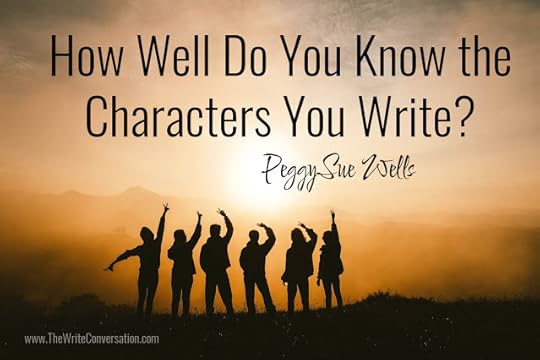
by PeggySue Wells @PeggySueWells
Do you know your character well enough to discern when they are lying?
The definition of character is the organization and structure of a person’s character or personality. As the author—creator—of your story, the better you know your character the more three-dimensional the personality will be to your reader.
For instance, in Fyodor Dostoyevsky’s 1866 novel, Crime and Punishment, Porfiry Petrovich is the head of the investigation department in charge of solving two murders. The Saint Petersburg detective encounters an innocent man who claims he committed the crime and a guilty man who denies he did the crime. The detective solves the mystery by knowing the deep aspects of the characters—what each is capable of and what each cannot do. Who is capable of lying and who is not. Who is capable of murder and who is not.
As an author, it is important to know your characters that well. Each character has their own backstory, settings and events that mold the interior and exterior of a person to be who they are. As Captain Jack Sparrow said in Pirates of the Caribbean, “The only rules that really matter are these: what a man can do and what a man can’t do.”
The more a writer knows the personality, background, and motivations about the character, the more compelling the story.Why is Indiana Jones afraid of snakes? Why is the Idumaean Herod so jealous for his throne as ruler of the Jews that he will kill babies?What happened in Jai Yao’s childhood that makes him capable of kidnapping Marc Wayne in The Patent?Make certain that actions and dialog align with each character’s personality by doing an intake sheet for each character in the same fashion a counselor would do. This background information will prove valuable, providing insight into events that shaped what your character can do and what they cannot do.
Begin With the Basics What are the first influences that shaped your character?
Outward Appearance Age Sex Height Weight Hair and eye color Build Way of moving How does your character speak?
BeginningAbout the character’s beginning, was the birth planned, the child wanted, named for someone? Where did the character fall in the family birth order?
How old were the parents when the child was born? Did the mother experience good health? Was the birth easy or complicated? Did the child have good nutrition? Childhood diseases? What expectations did the parents have for their child? How prepared were the parents to be parents?
What socioeconomical status did the child grow up in? Were finances adequate, abundant, withheld, or lacking? Where and when did your character grow up? Culturally, what was happening in the child’s circle, neighborhood, country, and world?
Early LifeWhile young, did the child experience the loss of significant people? Bond well or not with important people such as mother, father, siblings, extended family, neighbors, teachers, coaches? Did the family have pets? What scenarios impacted the child’s ability to trust?
How well did the child learn? What education was available? Who were significant peers? Best friends? Mentors? What was the child’s temperament toward others and self? What early life experiences made a lasting impact on the character?
For some, what the character can do and can’t do will remain steady. For others, the story arc will provide the reader with believable reasons for your character to change what they can do and can’t do.
Fill in the questions above to know what influences in your character’s formative years made your character who they are when your reader first meets them.
TWEETABLEHow Well Do You Know the Characters You Write? Tips from @PeggySueWells on @EdieMelson (Click to Tweet)
 Tropical island votary and history buff, PeggySue Wells parasails, skydives, snorkels, scuba dives, and has taken (but not passed) pilot training. Writing from the 100-Acre Wood in Indiana, Wells is the bestselling author of thirty books including The Slave Across the Street, Slavery in the Land of the Free, Bonding With Your Child Through Boundaries, Homeless for the Holidays, Chasing Sunrise, and The Ten Best Decisions A Single Mom Can Make. Founder of SingleMomCircle.com, PeggySue is named for the Buddy Holly song with the great drumbeat. At school author visits, she teaches students the secrets to writing and speaks at events and conferences. Connect with her at www.PeggySueWells.com, on Facebook at PeggySue Wells, and LinkedIn at linkedin.com/in/peggysuewells
Tropical island votary and history buff, PeggySue Wells parasails, skydives, snorkels, scuba dives, and has taken (but not passed) pilot training. Writing from the 100-Acre Wood in Indiana, Wells is the bestselling author of thirty books including The Slave Across the Street, Slavery in the Land of the Free, Bonding With Your Child Through Boundaries, Homeless for the Holidays, Chasing Sunrise, and The Ten Best Decisions A Single Mom Can Make. Founder of SingleMomCircle.com, PeggySue is named for the Buddy Holly song with the great drumbeat. At school author visits, she teaches students the secrets to writing and speaks at events and conferences. Connect with her at www.PeggySueWells.com, on Facebook at PeggySue Wells, and LinkedIn at linkedin.com/in/peggysuewellsFeatured Image: Photo by Chang Duong on Unsplash
July 3, 2022
Listening as a Proofreading Tool for Writers
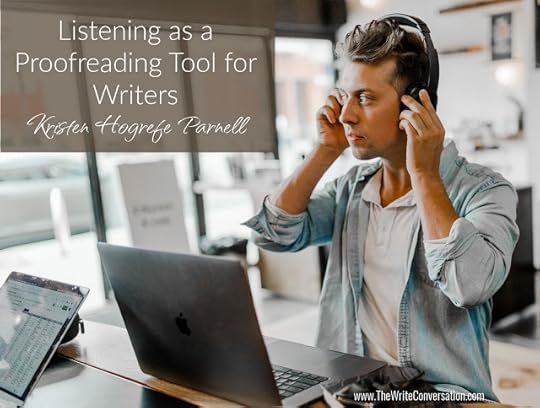
by Kristen Hogrefe Parnell @KHogrefeParnell
Our mothers told us that God gave us two ears and one mouth for a reason. But have we ever considered the value that listening can offer for proofreading our manuscripts?
That’s right, proofreading. Although we’re not strangers to audio books and immersive reading, I’d like to share a personal story that showed me the benefit of incorporating listening as a proofreading activity.
Blue Ridge Road TripLast month, my husband and I drove from Florida to Asheville for the Blue Ridge Mountains Christian Writers Conference. While I was there, my editor emailed my proofreading copy of my upcoming novel. I thanked her for sending it and figured I would print it out and start reviewing it when I returned home.
But as we pulled away from the beautiful Ridgecrest Conference Center and started the journey home, I thought to myself: I have almost ten hours in this car. Surely, I can get started on my manuscript.
The thought of reading it on my laptop made my eyes water, so I did a Google search for ways to listen to Word documents. Turns out, I didn’t need to look beyond Microsoft Word.
Windows 10 Read-Aloud Feature
As long as you have Windows 10 or newer, you can take advantage of this tool. On your Quick Access Toolbar, select the dropdown for more options to “Customize Quick Access Toolbar.”Choose “More commands.”In the “Choose commands from” dropdown, select “All commands.”Find the “Speech” command and “Add” it. Choose OK.You should now see a new symbol on the Quick Access Toolbar that looks like an A with sound waves. When you click on it, you can choose “Read aloud,” and a computer narrator will begin reading wherever your cursor is on your page.
Not only did this lovely tool save my eyes, but I discovered that listening to my manuscript reveals errors that even the sharpest eye will overlook.
Mistakes Caught by Listening
For example’s sake and full transparency that even this English teacher can skim over errors, I want to share some types of mistakes that listening to my manuscript helped me catch.()Words you’re misspelling that Word isn’t flagging: My example is driveway, which I was consistently spelling driveawayfor whatever reason. I immediately caught the mistake when the speech tool pronounced drive-a-way.The wrong character’s name: It’s easy to type one character’s name when we mean another, and when we skim over text, our brains might read the one we intended. When we hear the wrong name though, we realize the sentence doesn’t make sense.Overused words: We might not notice that we used the word “tight” in the previous sentence unless we hear the word “tight” twice within a few lines. Our ears catch the redundancy.Too much internal monologue: One scene needed more action and less time spent inside my character’s head. Only when I “heard” the passage did I realize how much the internal monologue was slowing that scene’s pacing and that I needed to cut out a large portion.Typos that spell check misses: For example, “now” instead of “know.”Missing words: Our brains sometimes insert missing words, because we know how the line should read, but listening to a line with a missing word reveals the problem.
Word’s Speech command certainly isn’t the only way to “listen” to your manuscript before it goes to print, but its accessibility made it perfect for my road trip.
Have you ever used a listening tool to help you proofread your manuscript? If not, I challenge you to try one.
TWEETABLEListening as a Proofreading Tool for Writers, tips from @KHogrefeParnell on @EdieMelson (Click to Tweet)
 Kristen Hogrefe Parnell writes suspenseful fiction from a faith perspective for teens and adults. Her own suspense story involved waiting on God into her thirties to meet her husband, and she desires to keep embracing God’s plan for her life when it’s not what she expects. She also teaches English online and is an inspirational speaker for schools, churches, and podcasts. Her young adult dystopian novels, The Revisionary and The Reactionary, both won the Selah for speculative fiction, and her first romantic suspense novel with Mountain Brook Ink releases this December. Kristen and her husband live in Florida and are excited to welcome their first baby in August. Connect with her at KristenHogrefeParnell.com.
Kristen Hogrefe Parnell writes suspenseful fiction from a faith perspective for teens and adults. Her own suspense story involved waiting on God into her thirties to meet her husband, and she desires to keep embracing God’s plan for her life when it’s not what she expects. She also teaches English online and is an inspirational speaker for schools, churches, and podcasts. Her young adult dystopian novels, The Revisionary and The Reactionary, both won the Selah for speculative fiction, and her first romantic suspense novel with Mountain Brook Ink releases this December. Kristen and her husband live in Florida and are excited to welcome their first baby in August. Connect with her at KristenHogrefeParnell.com.Featured Image: Photo by Austin Distel on Unsplash
July 2, 2022
Freedom Writer

by Audrey Frank @AudreyCFrank
The Spirit of the Sovereign Lord is on me, because the Lord has anointed me to proclaim good news to the poor. He has sent me to bind up the brokenhearted, to proclaim freedom for the captives and release from darkness for the prisoners…Isaiah 61:1
He was one of their own, a local boy known by everyone. Many an evening he had walked the dusty road, covered in wood shavings, after a long day helping his father in the carpenter shop. He was nothing extraordinary.
But here he was on the Sabbath, all grown up, sitting right in the honored center of the synagogue, the same synagogue his mother Mary had led him and his brothers to every Sabbath for years.
No one spoke as he opened the scroll of the prophet Isaiah. No one dared breathe.
The Spirit of the Sovereign Lord is on me, because He has anointed me to proclaim good news to the poor. He has sent me to proclaim freedom for the prisoners and recovery of sight for the blind, to set the oppressed free, to proclaim the year of the Lord’s favor.
Every eye in the room was riveted on him as he continued.
Today this Scripture has been fulfilled in your hearing.
This sacred moment was the culmination of every freedom writer’s dream, the instant when the message is fulfilled and freedom is unleashed to do its marvelous work of liberation.
Someone has to capture the words, to cast the vision. Someone has to take up a pen and seize the truth, fastening it with ink to paper where it can live and grow.
Writing is just the beginning, but it prepares the way for the Redeemer.
Isaiah was a freedom writer. Chapters 60 and 61 of his book are among the most read, most quoted passages in the Bible. And one can understand why!
His approach in was tantalizing and twofold. In chapter 60, he describes the future blessing of God’s people, encompassing the nations of the earth. In chapter 61, he describes the One who will bring that blessing, the Messiah Jesus.
Freedom writing can really be that simple.
Describe the blessing, describe the One who brings it, and wait for Him.
Today’s world is not so unlike the Israel of Isaiah’s time. We live on a globe groaning against oppression, longing for freedom. Cultural, social, political, spiritual exile may be in our future. Yet there is a Redeemer, and He has secured a future of freedom for the nations. Who will declare His coming? Who will encourage the brokenhearted, the captives?
I will.
And in the meantime, with my words, I will wait for Him. Join me?
Lord, let me be your freedom writer, declaring the blessing of liberty and the One who brings it. Amen.
TWEETABLEFreedom Writer, insights from author @AudreyCFrank on @EdieMelson (Click to Tweet)
 Audrey Frank is an author, speaker, and storyteller. The stories she shares are brave and true. They give voice to those whose words are silenced by shame, the hard things in life that don’t make sense, and the losses that leave us wondering if we will survive. Audrey and her family have spent over twenty years living and working among different cultures and world views, and she has found that God’s story of redemption spans every geography and culture. He is the God of Instead, giving honor instead of shame, gladness instead of mourning, hope instead of despair. Although she has three different degrees in communication and intercultural studies, Audrey’s greatest credential is that she is known and loved by the One who made her.
Audrey Frank is an author, speaker, and storyteller. The stories she shares are brave and true. They give voice to those whose words are silenced by shame, the hard things in life that don’t make sense, and the losses that leave us wondering if we will survive. Audrey and her family have spent over twenty years living and working among different cultures and world views, and she has found that God’s story of redemption spans every geography and culture. He is the God of Instead, giving honor instead of shame, gladness instead of mourning, hope instead of despair. Although she has three different degrees in communication and intercultural studies, Audrey’s greatest credential is that she is known and loved by the One who made her.Audrey is the author of Covered Glory: The Face of Honor and Shame in the Muslim World (Harvest House Publishers), an outpouring of Audrey’s heart to introduce others to the God of Instead. Shame is not unique to the developing world, the plight of the women behind veils, young girls trafficked across borders; shame is lurking in hearts everywhere. Through powerful stories from women around the world, Covered Glory illuminates the power of the Gospel to remove shame, giving honor instead. Available at favorite booksellers: BARNES & NOBLE , BOOKS A MILLION, AMAZON.
Featured Image: Photo by Vaishakh pillai on Unsplash
July 1, 2022
Packing for the Writer’s Journey

by Tim Suddeth @TimSuddeth
As I’m writing this, I’m preparing to travel to another writers’ conference. I’m really looking forward to going. I’ve been there before, and I know I’ll enjoy meeting old friends again and making new ones. I’m also excited about the opportunities I might encounter.
Then, when I get out the map and look at the route I have to take, and how long I’ll have to drive, it’s going to demand a lot. And it’s going to be hot. And did I mention that I have to pay for it?
Like most things in life, going to a conference or a retreat demands a lot of things. And when I focus on the demands, I quickly get discouraged and wonder, is it worth it?
But when I consider the destination—the classes I’ll attend, the writing professionals and friends I’ll meet—that’s when I truly can determine whether it’s worth it or not.
When I leave to go on my journey, I’ll need to make sure I have a few things: a map, enough time to drive, and enough money.
Writing works the same way. There are some things you need to be sure you have as you travel on your writing journey.
What to Pack for the Writing Journey
1. Commitment. To have a successful journey, however you want to define it, you have to believe. In yourself, and in your actions.
I know that’s hard. When you first start out as a writer, you don’t know what you’re doing. (How’s that for encouragement?) There is too much to know about the craft and the business for any new writer to make knowledgeable decisions. And so many options for the writer to consider.
In every writer’s journey, you are going to face rejection and disappointment. It’s normal to get discouraged. In fact, I haven’t read of any writer, including Hemingway and Fitzgerald, who hasn’t faced discouragement in their writing.
The key to continuing is to keep learning and to keep trying. Commit to the goal and realize that even falling could get you closer to your goal.
2. Patience. A struggle that I’ll face on my trip is watching the clock as I get closer to the conference center. I have to be there at two. I know that as the clock ticks, I’m going to worry about being in the class on time.
In writing, I don’t look at the watch, but I am tempted to look at the calendar. And the pages seem to turn way too often. Whether it’s a deadline, finding an agent, or getting published, it’s hard not to wish it would come in my time.
And when it doesn’t, and my friend gets published, again. Discouragement pops up in the seat next to me, whispering in my ear. I have to remind myself that I haven’t reached MY destination yet.
Getting published may be my desire, but if I’m trusting and following God’s will for my life, how and when is up to Him. There must be more that I need to learn, or God has something else planned for me.
3. Diligence. Telling a story is hard work. Anybody can put words on a page, but finding the right words, the right theme, and the right tone takes the ‘write’ mind. (I can already hear the groans.)
Writing is hard. Then putting it out into the world and hearing other’s criticisms can be heartbreaking. Why can’t they see the beautiful story I had in my head instead of the mush of words that now lie on the paper?
But keep at it. We often make the same mistakes that other writers make. And by studying them, and writing more stories, we will see our tendencies and learn how to correct them or not commit them.
4. Vigilance. Many of us have a goal in mind when we start: to write an American best-selling novel, or a groundbreaking movie, or an article for Guidepost that changes lives. I hope you never lose that dream. But while you’re learning the lessons, you need to reach those goals, don’t miss out on other opportunities that may pop up.
When I became a writer, one of the first things I did was to attend a local writers’ group. (Shout out to Word Weavers.) I knew I enjoyed writing, but I didn’t have a clue what that really meant. Don’t all writers smoke pipes, have bad hair, and live in New York City?
After the greetings, the group went around the group and mentioned any successes they’d had that month. And it was eye-opening. Someone started a blog, someone had an article published in a magazine, someone else had a book coming out, another person had a rejection but sent the article to another magazine. There were so many opportunities I had never considered.
5. Joy. The journey can be long and hard. Enjoy it. Some great people will pass through your life. Get to know them.
You will have a lot of minor victories. Relish them. And celebrate the victories of others.
It scares me to think how easy it would be to miss the joys and blessings God has scattered in our lives because we are so concerned about reaching the destination.
These are some things I’ll pack, not just for my trip, but also for my journey. I think James L. Rubart said it well. “It’s not about the writing. It’s about the person you’re being shaped and molded into through the writing and the writing world. So do your best. Then breathe deep and let it go.”
TWEETABLEPacking for the Writer's Journey, tips from @TimSuddeth on @EdieMelson (Click to Tweet)
 Tim Suddeth is a stay-at-home dad and butler for his wonderful, adult son with autism. He has written numerous blogs posts, short stories, and three novels waiting for publication. He is a frequent attendee at writers’ conferences, including the Blue Ridge Mountain Christian Writers Conference and a member of Word Weavers and ACFW. He lives near Greenville, SC where he shares a house with a bossy Shorky and three too-curious Persians. You can find him on Facebook and Twitter, as well as at www.timingreenville.com and www.openingamystery.com.
Tim Suddeth is a stay-at-home dad and butler for his wonderful, adult son with autism. He has written numerous blogs posts, short stories, and three novels waiting for publication. He is a frequent attendee at writers’ conferences, including the Blue Ridge Mountain Christian Writers Conference and a member of Word Weavers and ACFW. He lives near Greenville, SC where he shares a house with a bossy Shorky and three too-curious Persians. You can find him on Facebook and Twitter, as well as at www.timingreenville.com and www.openingamystery.com.Featured Image: Photo by LinkedIn Sales Solutions on Unsplash
June 30, 2022
Writing an Un-Put-Downable Character (Part 6 of 10): Language

by A.C. Williams @ACW_Author
We are halfway through our ten steps to writing an awesome character! I hope this series has been useful. I love creating characters, so I’m delighted to be able to share what I’ve learned.
Last week we talked about how giving your characters interests makes them feel well-rounded and fully realized. Today, we’re going to talk about Language.
Language is one of the most valuable tools you have to show readers information about your characters without having to tell them. Generally when I talk about a character’s language in a story, I focus on three areas: Dialect, Vocabulary, and Idiom.
Dialect
Dialect is usually what most people think of when we bring up using language to flesh out a character. Dialect is the intentional misspelling of words to represent a character’s accent, cultural upbringing, or education level.
Some authors have done it well. Notable examples are The Adventures of Huckleberry Finn (Mark Twain), To Kill a Mockingbird (Harper Lee), and the Harry Potter books (J.K. Rowling). But writing dialect walks a narrow line between characterization and stereotyping. It’s become a bit of a hot button issue in modern times.
Beyond the potential for offending people, writing in a dialect can be really confusing to readers. If your readers are struggling to understand the misspelled words, it will take them out of the story.
This is why I normally recommend other ways of expressing accent, culture, or education in storytelling. Sure, there are times when some dialectical writing will add depth to a character, but in my opinion, it should be used sparingly.
Vocabulary
Have you eaten a bowl of Hoppin’ John? What about Carolina peas and rice? Or what about some tasty black-eyed peas on rice? Yes, they are all the same dish. But depending on where you are within the United States, people call it by different names. (Pop, soda, or coke, anyone?)
One of the best ways you can use language to develop a character is to know how they speak. What words would they use? Take Texas and Georgia for example. Both states are what would generally be called The South, but their cultures are completely different. If you want boiled peanuts, fresh peaches, and access to great Cuban or Jamaican food, Georgia is a better bet. If you want a great steak, Mexican culture, and more cowboy hats than you can shake a stick at, go to Texas.
These are just examples within the U.S. Venture out a bit more to a country like England or Russia or Japan, and you’ll find some spectacular regional dialects that will very easily show a reader where a character is from. You just have to do your research.
Idiom
Has anyone ever pulled the fur over your ears? No? What about the wool over your eyes?
Do you know what it would mean to watch carrots grow from underneath? Maybe you’re more familiar with pushing up daisies?
In case you aren’t familiar with idiom, it’s metaphorical language we use to communicate a feeling, a thought, or a concept using the terms of something else.
Kick the bucket. Piece of cake. Raining cats and dogs. Kill two birds with one stone. Letting the cat out of the bag. The list goes on and on and on.
But here’s the thing about idiom: It changes from culture to culture.
Idiom is awesome. But it is the hardest tool to use when you’re trying to create a character. You probably guessed that both of those examples above are idiom. One is American. The other is German. I worked for a German company for five years, and one of my colleagues grew up in the Black Forest. So we had a lot of conversations about the differences and surprising similarities between American and German idiom.
If you’re going to use idiom in your characterization, be sure that you are very experienced in the culture you’re writing. Much like dialect, if you just try to wing this, you could end up insulting someone. So be sure you know the culture you’re using, and always make sure you have a sensitivity reader as well.
But what about speculative fiction?
With speculative fiction (science fiction and fantasy), you get to create the world where your characters play. You create their language, their culture, their idiom, etc. Isn’t that easier than writing contemporary or historical fiction?
Not at all.
Whatever world you build in your speculative fiction novel or series, it must be complete, cohesive, and consistent. You can’t just drop random words or sayings into your characters’ conversations without having some reason for them to be there. In this way, writing speculative fiction is actually a bit more challenging than other genres. For historical or contemporary fiction, you can look up a cultural norm, or you can interview someone from that culture to help you understand how to proceed. With speculative fiction, all of that information must come from your own imagination.
If you’re wired that way, go for it. Just be sure you take that into account before you create a world.
Listen to people around you, how they talk, what they say, why they say it. You’re surrounded by examples of linguistic characterization every day. So keep your ears open.
Here’s where we are in our ten-step journey!
Personality Conflict Contradictions History Interests Language Internalization Dreams Observables Growth
TWEETABLEWriting an Un-Put-Downable Character (Part 6 of 10): Language, from @ACW_Author on @EdieMelson (Click to Tweet)
Don't Miss the Other Posts in This Series
PART 1 PERSONALITY: WRITING THE UN-PUT-DOWNABLE CHARACTER
PART 2 CONFLICT: WRITING THE UN-PUT-DOWNABLE CHARACTER
PART 3 CONTRACTIONS: WRITING THE UN-PUT-DOWNABLE CHARACTER
PART 4 HISTORY: WRITING THE UN-PUT-DOWNABLE CHARACTER
PART 5 INTERESTS: WRITING THE UN-PUT-DOWNABLE CHARACTERPART 6 LANGUAGE: WRITING THE UN-PUT-DOWNABLE CHARACTER
 Award-winning author, A.C. Williams is a coffee-drinking, sushi-eating, story-telling nerd who loves cats, country living, and all things Japanese. She’d rather be barefoot, and if she isn’t, her socks won’t match. She has authored eight novels, two novellas, three devotional books, and more flash fiction than you can shake a stick at. A senior partner at the award-winning Uncommon Universes Press, she is passionate about stories and the authors who write them. Learn more about her book coaching and follow her adventures online at https://www.amycwilliams.com.
Award-winning author, A.C. Williams is a coffee-drinking, sushi-eating, story-telling nerd who loves cats, country living, and all things Japanese. She’d rather be barefoot, and if she isn’t, her socks won’t match. She has authored eight novels, two novellas, three devotional books, and more flash fiction than you can shake a stick at. A senior partner at the award-winning Uncommon Universes Press, she is passionate about stories and the authors who write them. Learn more about her book coaching and follow her adventures online at https://www.amycwilliams.com.
June 29, 2022
Tips for Vision Problems in Speakers and Writers

by Yvonne Ortega @YvonneOrtega1
The most common vision problems for writers are pink eye, vision loss, and dry eye. We will look at them one at a time.
Pink Eye
Pink eye is an infection or inflammation of the outer membrane of the eyeball and the inner eyelid. Symptoms may include eye redness, pain, and irritation. One of my speaker friends said, “I woke up with eye irritation in one eye, rubbed it to get rid of the discomfort, and spread it to the other eye. Ignorance is not always bliss.
Because of how she looked, she called her eye doctor. She discovered that pink eye—also called conjunctivitis—can be allergic, bacterial, chemical, or viral. Her eye specialist helped her with treatment options and congratulated her for seeking care without delay. She said, “If you had a thief in your home, you would not welcome him.” I said, “Don’t welcome the thief that has invaded your eyes.”
Vision Loss
Vision loss is the inability to see correctly. Don’t let that thief sit for tea with you and then literally rob you blind of vision. Be proactive.
The most common vision loss is central field vision—the vision we have when we look straight ahead. It is not the same as peripheral vision when we look to the left or to the right. The central field vision includes everything we can see including the peripheral vision.
An eye doctor and specialist team can restore vision loss with early intervention. If the underlying cause is diabetes, they can help manage it. If it is macular degeneration, they can treat it or surgically repair macular holes. Although this article doesn’t cover macular degeneration and cataracts, you can check with your eye doctor and team or research both online.
Dry Eye
Dry eye occurs when tears can’t produce adequate moisture. Symptoms include dryness of the eyes, discomfort, and redness of the eyes. One woman handled the blog and copyediting at work. She told me, “I ignored all symptoms of dry eye. I took care of my husband and the children plus all the writing emergencies at work. Now I suffer the consequences.”
One of the causes of dry eye is prolonged computer use. Kick the thief out and take breaks. Other causes include contact lenses along with contact lens solution sensitivity; sunny, dry, or windy conditions; air conditioning, dehumidifiers, fans, and heaters; high altitudes, dust, pollen, and smoke. As we age, tear production decreases. However, men and women of any age can suffer from dry eye. Some medications, such as antihistamines, antidepressants, and decongestants cause dry eye. Autoimmune diseases and disorders like rheumatoid arthritis, Crohn’s disease, and Sjogren’s syndrome can cause dry eye.
For relief from dry eye, we can turn to eye drops, a warm washcloth on our eyes, or a hot and cold compress. My doctor advised me to hold a warm washcloth over my eyes first thing in the morning and at bedtime and to use eye drops throughout the day. Your eye specialist may recommend the 20-20-20 rule—for every 20 minutes you look at the computer screen, look at something 20 feet away for 20 seconds.
“If any of you lacks wisdom, let him ask God, who gives generously to all without reproach, and it will be given him” (James 1:5 ESV).
Which tip do you practice? Which one do you need?
TWEETABLETips for Vision Problems in Speakers and Writers from @YvonneOrtega1 on @EdieMelson (Click to Tweet)
 Yvonne Ortega walks with a small footprint but leaves a giant imprint in people’s lives. This power-packed package is a professional speaker and the author of the Moving from Broken to Beautiful® Series through cancer, divorce, forgiveness, and loss. Learn more at WWW.YVONNEORTEGA.COM
Yvonne Ortega walks with a small footprint but leaves a giant imprint in people’s lives. This power-packed package is a professional speaker and the author of the Moving from Broken to Beautiful® Series through cancer, divorce, forgiveness, and loss. Learn more at WWW.YVONNEORTEGA.COMYvonne speaks with honesty and humor as she shares her life and struggles through presentations that empower women to find peace, power, and purpose through God’s Word.
Yvonne’s background as a licensed professional counselor brings a unique perspective into the heart of women. She’s a speaking and writing coach and the owner of Moving from Broken to Beautiful®, LLC. She belongs to the Advanced Writers and Speakers Association, the Christian Authors Network, the National Speakers Association, and Toastmasters International.
She celebrates life at the beach, where she walks, builds sand castles, blows bubbles, and dances.
Featured Image: Photo by K8 on Unsplash
June 28, 2022
Threads in the Writing Tapestry

by Kay DiBianca @KDiBianca
My husband and I had the good fortune to visit the Vatican Galleries in Rome some years ago. One memory I have was standing in front of several enormous tapestries that recorded events from the Gospels. I was astounded at the workmanship that told a story by weaving different color threads onto a background. I wondered if the weavers had used any special thread, maybe a gold or silver one, to highlight each one of his works.
It’s not much of a leap to compare the creation of a colorful, intricate tapestry with a novel. Both tell a story, but each uses a different set of raw materials. I began to think of my own novels as stories woven with individual words that produce a complex whole.
When I began my Watch series of cozy mysteries, I had not intended to weave certain threads through each of the novels. The main characters, of course, are the foundation around which all the rest of the stories revolve. But I found several other threads made their way through each of the books without my explicitly planning it that way. Here are four of them.
1. I’m a runner, so it’s not surprising that there are running scenes in each book. The first book begins with one of the main characters, Kathryn, training for a marathon. The second novel has the same character injured during a half-marathon, and the third story includes references to running.
2. The other main character in my books, Cece, is an actress, and she loves disguises. In each one of the books, Cece goes into disguise at least once, sometimes with surprising consequences.
3. Each book also contains a chapter describing a Shabbat dinner. As the diners enter into the Sabbath during the meal, something illuminating always happens.
I did not intentionally add those three elements to my series. They just happened to fit well into each story. However, a fourth thread is one that I determined I would add to every book I write:
4. My husband, Frank, coined a word when he invented and patented a medical imaging device which he named the Kinestatic Charge Detector. Although you won’t find the word “kinestatic” in the dictionary, you will always find it used at least once in each of my books. “Kinestatic” means something that is moving (kinetic) in one frame of reference, but still (static) in another. A good example is a runner on a treadmill. The runner is moving with regard to the treadmill, but still in regard to the room. The word can be used to describe so much in life. One example is running around all day doing errands, but feeling like you haven’t accomplished anything.
So these are the threads that keep popping up in my tapestry-novels. I hope they serve as tiny reminders to reassure readers they’re in familiar and comfortable territory.
Do you weave threads through your stories to add a sense of familiarity for your readers?
Kay DiBianca is a former software developer and IT manager who retired to become an award-winning author of cozy mysteries. She loves to create literary puzzles for her readers to solve, and her characters come to life as they struggle to solve murders and create relationships amidst the ongoing themes of faith and family.
TWEETABLEThreads in the Writing Tapestry, insight from author @KDiBianca on @EdieMelson (Click to Tweet)
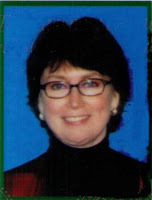 Kay is a member of the American Christian Fiction Writers, Sisters in Crime, and the Collierville Christian Writers Group. She is also a regular contributor to the Kill Zone Blog. An avid runner, she can often be found at a nearby track, on the treadmill, or at a large park near her home. Kay and her husband, Frank, live, run, and write in Memphis, Tennessee. You can connect with Kay through her website at https://kaydibianca.com.
Kay is a member of the American Christian Fiction Writers, Sisters in Crime, and the Collierville Christian Writers Group. She is also a regular contributor to the Kill Zone Blog. An avid runner, she can often be found at a nearby track, on the treadmill, or at a large park near her home. Kay and her husband, Frank, live, run, and write in Memphis, Tennessee. You can connect with Kay through her website at https://kaydibianca.com.
June 27, 2022
The Best Tip to Stop Neck Pain for Writers

by Ginny Cruz MPA, PT
Writers understand pain. They live with piercing stabs from rejection, dull aches from embedded insecurity, and throbbing neck pain caused by long hours at the writing desk.
Most cases of neck pain in writers are caused or worsened by poor posture while writing. Most of us, nowadays, write on a computer. We sit staring at either a laptop screen (possibly balanced delicately on our laps) or at a computer on a desk. Either arrangement is usually a clue to why you experience neck pain while writing.
Poor neck alignment, such as when you look down for long periods, creates muscle fatigue and tension. Fatigue and tension can cause muscle spasms. One spasm often leads to two or more. This cycle can continue until you have multiple knots in the neck and shoulders.
Muscle spasms occur when your muscle strains to the point individual muscle fibers tear. As a result, the muscle "tightens up" the surrounding fibers to protect from further tearing and damage. That "tightening up" is the spasm you feel. In addition, when a muscle tightens up, it creates chemicals (toxins) that also cause pain.
If you've ever had knots in your neck or shoulders, you've probably applied heat and done a few stretches to feel better. Often this works because heat relaxes the muscle spasm and increases the blood flow to the area. More blood in means more blood out. As the blood leaves the painful area, it takes the toxins that cause pain. Therefore, fewer toxins equal less pain.
As a physical therapist, I know the best tip to stop neck pain is to prevent the muscle strain and spasm cycle from starting. The way to do accomplish this is to eliminate the poor posture that created the pain in the first place.
To make changes to your writing posture, begin by taking an honest assessment of your sitting position when you write. It helps to have someone take a photo of you from the side so you can see the posture of your neck. Are you looking down similar to how teenage texters appear? Are your shoulders rounded forward? Or are you craning your neck up a bit so you can see through your reading glasses?
Most of us, myself included, need to make minor adjustments to the height of our computer screen to avoid looking down or up too much. Since I write at a desk using my laptop and wear progressive lenses, I place my computer on a stand three-and-a-half inches high. This height allows me to see my screen while looking straight ahead.
Maybe you can use large books (I trust you have a few) to raise your screen slightly. Or you may need to raise your chair to look down to see your screen. It will take a little tinkering to get the ideal height. The best height is one where your neck is neither craned down or up.
Yes, this new position may feel different and may take some time to adjust to. However, the old adage is true: an ounce of prevention is worth a pound of cure. Preventing the strain in your neck muscles will prevent muscle spasms and pain from occurring.
You may also consider the wide variety of adjustable computer stands on the market. Standing desks are also popular, and their height adjustability makes them an option that works for many. Standing up frequently also helps alleviate back pain (see my Tips to Keep Your Writer’s Back Healthy).
I hope this tip of adjusting the height of your computer screen stops your neck pain. With all the other pains we writers live with, at least we can do something to eliminate the pain in the neck.
Does neck pain interfere with your writing?
(Disclaimer: If you are under the care of a physician, chiropractor, or physical therapist for neck or back pain, check with them before beginning any exercise program. Again, this information is not prescriptive for your specific condition but only general education.)
TWEETABLEThe Best Tip to Stop Neck Pain for Writers from Ginny Cruz on @EdieMelson (Click to Tweet)
 Ginny Cruz, MPA, PT is a pediatric physical therapist, early intervention specialist, and award-winning author. Her writing encourages and teaches moms simple and effective ways to help their baby meet developmental milestones. In addition to writing, she enjoys hiking, reading, and camping with her husband. Find out more at ginnycruz.com, Instagram, or Facebook.
Ginny Cruz, MPA, PT is a pediatric physical therapist, early intervention specialist, and award-winning author. Her writing encourages and teaches moms simple and effective ways to help their baby meet developmental milestones. In addition to writing, she enjoys hiking, reading, and camping with her husband. Find out more at ginnycruz.com, Instagram, or Facebook.Featured Image: Photo by Taisiia Shestopal on Unsplash
June 26, 2022
Brainstorming Alone? Use Storyboarding to Create Your Story

by Ane Mulligan @AneMulligan
At the beginning of the month, I taught a class at the BRMCWC (Blue Ridge Christian Writers Conference) on Storyboarding. It's a method used by advertising agencies for years. I first used it when I was the creative arts director at my church. I was charged with writing scripts to illustrate or set-up our pastor's sermons. When I became a writer, I have used this method when I don't have a buddy to brainstorm with at the time.
All storybording takes is some sticky notes and blank wall space.
Are you a Plotters? Do you write out a detailed outline? Or are you SOTP (seat-of-the-pants)? I fall somewhere in between. When I started writing the book that became my first published novel, I was pretty much of a plotter. I had the beginning, the end, and a lot of the first third of my book plotted out.
Then, when I’d written those chapters, I’d grind to a halt and go back and storyboard another third or so. And that’s okay. Some of you will storyboard the entire book.First: Develop a “What if” idea. Second: Buy sticky notes. I use different colors for different characters (if more than one POV) and for conflict.Third: Do your character work: Find the MC’s GMC or as I like to use: Wants, Because, Why not. So, what is Storyboarding?
Storyboarding is visual brainstorming. Creatives in the advertising and comic book industries use storyboarding to lay out their ideas.
Why Storyboard?
Not everyone is good at plotting. Even if you’re SOTP, once you publish, your publisher will want a synopsis before you start writing. Unless you don’t want to send them a proposal until you’ve finished the book, you have to learn how to plot. They know the story can and probably will change from your initial proposal.
How to Storyboard
In group storyboarding, everyone contributes, no suggestion is off the table, nothing is dismissed as too silly or impossible, each idea thrown onto the board sparks another. It might be the umpteenth idea that turns out to be the best idea one. What if you stopped because one idea was silly? When the perfect one hits, everyone knows it.
Solo brainstorming
If you don’t have a group to work with, storyboarding can be a great way to brainstorm alone. It might take you a few minutes to get started, but if you begin with what you know, put a word or two for each on a sticky note and slap it up. Soon, your creativity will take over.
What Problems Plague You?
Conflict?Romantic encounters?Character arch?Theme?Inciting Incident? Black Moment?What others?
Use a separate sticky note color for that area.
Wall space
When I was a kid, I loved blank wall space. I grabbed a crayon and started writing. Blank wall space seems to beg us to get creative. So jot all those ideas on sticky notes and start slapping the, on the wall.
When the wall is covered
Once the wall is covered with stickies, move them around until you begin to see a flow. Then move them some more. When it looks good, put them in outline form on your computer.
Have you ever storyboarded? How did it work for you?
TWEETABLEBrainstorming Alone? Use Storyboarding to Create Your Story, tips from author @AneMulligan on @EdieMelson (Click to Tweet)
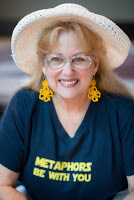 Ane Mulligan has been a voracious reader ever since her mom instilled within her a love of reading at age three, escaping into worlds otherwise unknown. But when Ane saw PETER PAN on stage, she was struck with a fever from which she never recovered—stage fever. And so, by night, she’s CEO of a community theatre company and by day, a bestselling, award-winning novelist. She lives in Sugar Hill, GA, with her artist husband and a rascally Rottweiler. Find Ane on her website, Amazon Author page, Facebook, Instagram, Pinterest, The Write Conversation, and Blue Ridge Conference Blog.
Ane Mulligan has been a voracious reader ever since her mom instilled within her a love of reading at age three, escaping into worlds otherwise unknown. But when Ane saw PETER PAN on stage, she was struck with a fever from which she never recovered—stage fever. And so, by night, she’s CEO of a community theatre company and by day, a bestselling, award-winning novelist. She lives in Sugar Hill, GA, with her artist husband and a rascally Rottweiler. Find Ane on her website, Amazon Author page, Facebook, Instagram, Pinterest, The Write Conversation, and Blue Ridge Conference Blog. Featured Image: Photo by Kelly Sikkema on Unsplash
A Comprehensive Explanation of Creative Nonfiction
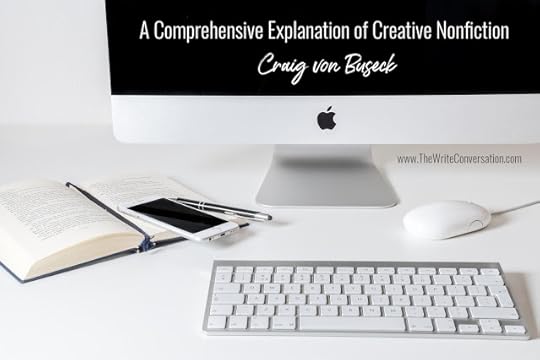
by Craig von Buseck @CraigVonBuseckCreative nonfiction is a blending of two previously separate literary worlds—and the results can be breathtaking. The genre—including narrative nonfiction and memoir—has become extremely popular, often dominating the best-seller lists.
The word ‘fiction’ comes from the Latin fictio, the act of fashioning. Merriam-Webster defines fiction as “something invented by the imagination or feigned specifically an invented story.”[i] Fiction is created by the imagination of the writer. It is not factual, though it is most often based on the real world and refers to it.
A DefinitionNonfiction is defined by Merriam-Webster as writing or cinema that is about facts and real events.[ii] This is a straight forward description that seems rather uncomplicated. The nonfiction writer draws from real life without making anything up, or worse, lying.
“I don’t know actually coined the term ‘creative nonfiction,’” writes Lee Gutkind. “I have been using it since the 1970s, although if we were to pinpoint a time when the term became ‘official,’ it would be 1983, at a meeting convened by the National Endowment for the Arts to deal with the question of what to call the genre as a category for the NEA’s creative writing fellowships. …the NEA had long recognized the ‘art’ of nonfiction and [had] been trying to describe the category so writers would understand what kind of work to submit for consideration.”
“‘Essay’ is the term used to describe this ‘artful’ nonfiction,” Gutkind recalls, “but it didn’t really capture the essence of the genre for the NEA or lots of other folks experimenting in the field. … ‘creative nonfiction’ precisely describes what the form is all about. The word ‘creative’ refers simply to the use of literary craft in presenting nonfiction—that is, factually accurate prose about real people and events—in a compelling, vivid manner. …creative nonfiction writers do not make things up; they make ideas and information that already exist more interesting and often more accessible.”[iii]
“The word ‘creative’ refers to the use of literary craft, the techniques of fiction writers, playwrights, and poets employ to present nonfiction—factually accurate prose about real people and events—in a compelling, vivid, dramatic manner. The goal is to make nonfiction stories read like fiction so that your readers are as enthralled by fact as they are by fantasy. But the stories are true.”[iv]
“The word ‘creative,’” writes Gutkind, “has to do with how the writer conceives ideas, summarizes situations, defines personalities, describes places—and shapes and presents information. ‘Creative’ doesn’t mean inventing what didn’t happen, reporting and describing what wasn’t there. It doesn’t mean that the writer has a license to lie. The word ‘nonfiction’ means the material is true.”
Gutkind emphasizes that in creative nonfiction, “you can’t make this stuff up!”[v]
“This may be creative nonfiction’s greatest asset,” argues Gutkind, “it offers flexibility and freedom while adhering to the basic tenets of reportage. In creative non-fiction, writers can be poetic and journalistic simultaneously. Creative nonfiction writers are encouraged to use literary and cinematic techniques, from scene to dialogue to description to point of view, to write about themselves and others, capturing real people and real life in ways that can and have changed the world.”
“The key concept in transitional narrative is that a dramatic story,” writes Jon Franklin, “whether it be the old fiction or the new nonfiction, must be a world unto itself … a world which the reader can enter and become absorbed in. This results from a phenomenon that short-story writers called ‘suspension of disbelief.’”
“In its original meaning, ‘suspension of disbelief’ had to do with the reader’s willingness to jump from the world of reality into the world of imagination,” writes Franklin. “With the rise of nonfiction drama, however, it has come to include the process by which the reader moves from his own reality to someone else’s equally real world.”[vi]
“This general meaning of the term is basically acknowledged and accepted in the literary world,” Lee Gutkind explains, “poets, fiction writers, and the creative writing community in general understand and accept the elements of creative nonfiction, although their individual interpretation of the genre’s boundaries may differ. The essential point to acknowledge here is that there are lines, real demarcation points among fiction, which is or can be mostly imagination; traditional nonfiction (journalism and scholarship), which is mostly information; and creative nonfiction, which presents or treats information using the tools of the fiction writer while maintaining allegiance to fact.”[vii]
Revenge of the Historians
An increasing number of historians have become creative nonfiction writers and are now being described as “narrative historians.” One of these, Ron Chernow, began his career as a freelance journalist, writing more than 60 articles in national newspapers and magazines from 1973 to 1982. Having spent time in the world of finance for a time, Chernow started writing biographies of great financiers of American history, including J. P. Morgan and John D. Rockefeller, Sr. In an attempt to avoid being caught in a rut of financial books, Chernow broke out with his 2004 release of Alexander Hamilton.
Chernow began the writing process for the Hamilton biography in 1998 by going through more than 22,000 pages of Hamilton’s papers and archival research.[viii] Chernow also took a deep dive into Hamilton’s personal history. He traveled to important Hamilton-related sites and archives. He held the dueling pistols used in the famous Burr–Hamilton duel. He visited the Saint Croix prison where Hamilton’s mother was held in jail. He traveled to the island of Bequia, the place where Hamilton’s father fled after abandoning his illegitimate son. Chernow even had a lock of Alexander’s hair genetically tested for his racial makeup.[ix]
The details from this in-depth research fascinated Lin-Manuel Miranda as he read Chernow’s Hamilton book while he was on vacation in 2008. Miranda was moved by Hamilton’s difficult childhood in the Caribbean islands and his courageous move to New York as a young man. He was greatly impressed by the dramatic role Hamilton played in the American Revolution and how he worked his way to eventually becoming the U.S. secretary of the treasury.
Miranda recognized that Chernow had presented an important American story—one that needed to be told. This inspired him to write a rap piece about Alexander Hamilton that he performed in 2009 at the White House Evening of Poetry, Music, and the Spoken Word before President Barack Obama and others.
In 2015, Miranda and his production company presented “Hamilton” the musical Off-Broadway at New York City’s Public Theater. The show featured a racially diverse cast, with Lin-Manuel starring in the main role of Alexander Hamilton. It was instantly successful and quickly made the move to Broadway in July of that year.
In 2016, the smash hit, “Hamilton,” received the Pulitzer Prize for Drama and was nominated for 16 Tony awards. The production won 11 Tony’s, including best musical. Lin-Manuel Miranda won Tony’s for best book and best original score.[x]
And the rest, as they say, is history.
“Strong writers of compelling narratives had, by the 1980s, taken over the popular market for history,” Lee Gutkind explains. “Unwilling to concede the past to nonprofessionals, some historians looked to strike back. But they knew that this meant rediscovering their field’s deep narrative traditions. It meant taking on the big topics. It also meant imitating the narrative strategies deployed so well by journalist-historians like Goodwin and Caro—with, of course, fatter footnotes and longer bibliographies.”
“Reflecting the trend,” he continues, “in 1989 Princeton Professor James M. McPherson crafted Battle Cry of Freedom, a vivid, even moving account of the military history of the Civil War. In the following decade Joseph Ellis, of Mount Holyoke College, published American Sphinx, an elegant look at the private Thomas Jefferson. This triggered a sort of founding fathers revival, as professors, this time with the journalists following, raced to see who would get out the next book on Hamilton, Jefferson, or Adams.”[xi]
Some of the most popular books in the last quarter century have been the product of these ‘narrative historians.’ Biographies and history books of note include the Pulitzer Prize-winning Truman by David McCullough; Team of Rivalsby Doris Kearns Goodwin, which won the Lincoln prize; The Immortal Life of Henrietta Lacks by Rebecca Skloot; The Rise of Theodore Roosevelt, by Edmund Morris, which won the Pulitzer Prize; Unbroken: A World War II Story of Survival, Resilience, and Redemption by Laura Hillenbrand; American Ulysses by Ronald C. White; Angela’s Ashes by Frank McCourt, winner of the Pulitzer Prize; and Washington: A Life by Ron Chernow.
I like to think of myself as a part of this august group of writers through my books I Am Cyrus and Victor!—with hopefully more exciting projects to come.
“History is scholarship,” says author and historian Stephen J. Pyne. “It is also art, and it is literature. It had no need to emulate fiction, morph into memoir, or become self-reverential. But those who write it do need to be conscious of their craft. And what is true for history is true for all serious nonfiction. The issue is not whether the writing is popular, but whether it is good, which is to say, whether it does what it intends.”[xii]
*Adapted from Craig’s new book, Telling the Truth: How to Write Narrative Nonfiction and Memoir—coming later this year from Bold Vision Books.
TWEETABLEA Comprehensive Explanation of Creative Nonfiction from @CraigVonBuseck on @EdieMelson (Click to Tweet)
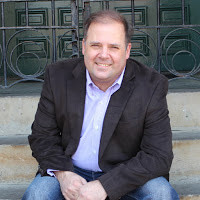 Dr. Craig von Buseck is an award-winning author, popular speaker, and the Digital Content Manager for the Parenting section of Focusonthefamily.org. More from Craig at vonbuseck.com
Dr. Craig von Buseck is an award-winning author, popular speaker, and the Digital Content Manager for the Parenting section of Focusonthefamily.org. More from Craig at vonbuseck.comMerriam-Webster Dictionary, “Fiction Definition”. https://www.merriam-webster.com/dicti.... Accessed April, 2022.
Merriam-Webster, “Nonfiction.” https://www.merriam-webster.com/dictionary/nonfiction. Accessed April, 2022.
Gutkind, Lee, Keep It Real, 11-12.
Gutkind, Lee, Editor, You Can’t Make This Up, 6.
Gutkind, Lee, Editor, You Can’t Make This Up, 7.
Franklin, Jon, Writing for Story, 138.
Gutkind, Lee, Keep It Real, 11-12.
Freeman, John, “Hamilton Envisioned U.S. Power.” South Florida Sun Sentinal. https://www.newspapers.com/clip/29575.... Accessed May, 2022.
Maslin, Janet. “Biographer Fills in Hamilton’s Background.” Arizona Republic. Accessed May, 2022.
Bedtime History, “The Story of Lin-Manuel Miranda and the Making of Hamilton,” BedtimeHistoryStories.com. https://bedtimehistorystories.com/the.... Accessed May, 2022.
Gutkind, Lee, Editor, Keep It Real, 76.
Pyne, Stephen J. Voice & Vision: A Guide to Writing History and Other Serious Nonfiction (Cambridge, MA: Harvard University Press, 2009), 2.



